If handled with care and due regard for the weather, there is no reason why you should capsize your sailing canoe. Most members can sail for years without capsizing. Taking care to reef early if the wind is increasing and practicing your sailing skills to become a competent sailor can reduce your risk of capsize to a minimum.
However it is sensible to be prepared in case a lapse of concentration or a sudden unexpected gust catches you out and you end up in the water. It is important to study what the techniques are and as soon as possible practice capsizing the canoe and re-entering it. This also tests the boat and how well it performs. Not all boats behave the same so it is best not to assume that it will work for you. It is best done with friends or other OCSG members standing by in case it fails and you need assistance. An OCSG meet is a good place to arrange this.

Canoes usually invert in a capsize. Mast head floats that are sometimes used on dinghies would be out of place on a narrow canoe that is easy to right, whereas larger dinghies can sometimes be very stable when inverted so preventing them from turtling can be important.
If your canoe inverts in a capsize, swim round to the side with the leeboard, take hold as high as you can reach, brace your feet or knees against the canoe and steadily pull back. This will slowly raise the mast to a horizontal position.

As the leeboard comes down to the water, change to pushing down on the board and pulling down on the gunwale/deck edge to slowly raise the mast out of the water, eventually righting the canoe.

Swim the canoe around till the wind is on your back. Position yourself at the centre of the canoe, reach into the middle and take good hold of a seat or thwart.
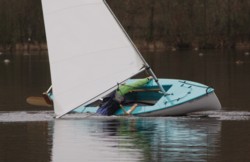
Kick your feet to get your feet and legs near the surface. Holding onto the near deck/gunwale, try to get out of the water as far as possible and reach for the far side.
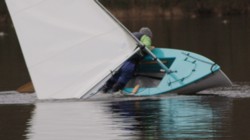
Pull yourself up and over the side into the canoe, trying to get as much weight over to the far side and evenly spread as quickly as possible, to avoid pulling the boat back on top of you. This is where side decks on a decked canoe can reduce the amount of water you take on.
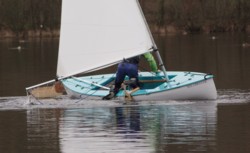
Finally climb back on board and bail out any water. An open canoe with buoyancy bags will take on a bit more water but the side bags should still support you and minimise the flooding.
Although we have successfully practiced this technique it can be difficult. The most common problem is the weight of the wet sail and mast pulling the canoe over as you try to get in. If there were two people on board one can hold onto the deck on the far side and help to stabilise the canoe. They should allow the canoe to heel towards you as you try to enter but not so much that it capsizes again.
If you are on your own you should always try to enter on the windward side. If you pull in the sheet as you try to enter the wind pressure on the sail should help to keep the canoe upright.
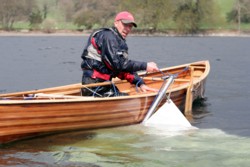
The most reliable solution is to remove the sailing rig when the canoe is upside down. This is why a free standing rig without a jib or standing rigging are best on cruising sailing canoes. Provided that the kicking strap is tight and the sheet is controlled via a turning block on the canoe with a knot in the end, the mast can be pulled out and will hang in the water under the canoe until it has been righted and you are back in.
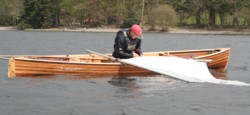
When you have sorted yourself out and bailed any water from the canoe you can pull on the sheet and retrieve the rig. The rig can be reefed whilst laying on deck and then re-stepped. Alternatively fold the rig away and paddle to the shore and re-step the mast there.
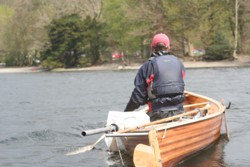
The important thing is to practice and find out which method suits you. Not only are all sailing canoes different, and might behave differently, making capsize recovery difficult, people are different too. What might work well for a fit 12st (75kg) younger sailor might not work for you if you are older, overweight or have lost some upper body strength. We usually wear dry suits when we are sailing and this allows plenty of time in the water before getting cold. Wearing a dry suit will also make it more pleasant trying capsize recovery, and more likely that you do practice regularly.
It is best to try this first on a fine day, near to shore with an onshore breeze, preferably in company. If you find that capsize recovery is impossible, you need to be thinking about changing your boat to one that won’t capsize such as a trimaran with large outriggers.